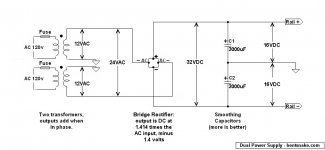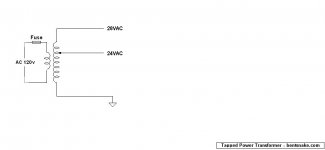.
Which leaves the poor poster wondering, well then, what is suitable?
Greenhead, you were better off before you started asking questions. OK here's how it works:
Transformers wired in series = voltage doubles, amperage stays the same.
Transformers wired in parallel = voltage stays the same, amperage doubles. (IMPORTANT: Do not wire transformers in parallel.)
Additional information: watts = volts x amps = VA
Pop quiz: Do you know about wired in series, as opposed to wired in parallel?
.
Which leaves the poor poster wondering, well then, what is suitable?
Greenhead, you were better off before you started asking questions. OK here's how it works:
Transformers wired in series = voltage doubles, amperage stays the same.
Transformers wired in parallel = voltage stays the same, amperage doubles. (IMPORTANT: Do not wire transformers in parallel.)
Additional information: watts = volts x amps = VA
Pop quiz: Do you know about wired in series, as opposed to wired in parallel?
.
Last edited:
.
Which leaves the poor poster wondering, well then, what is suitable?
Greenhead, you were better off before you started asking questions. OK here's how it works:
Transformers wired in series = voltage doubles, amperage stays the same.
Transformers wired in parallel = voltage stays the same, amperage doubles. (IMPORTANT: Do not wire transformers in parallel.)
Additional information: watts = volts x amps = VA
Pop quiz: Do you know about wired in series, as opposed to wired in parallel?
.
Thanks...that cleared up one thing for me (watts = VA) not sure why I never read that or figured it out.
I think one of my (many) points of confusion came from different types of transformers wiring their secondaries differently. On my toroids, I have 0V-24V-28V, so, putting the two 0V's together made sense, and I would then have two 24V's or two 28V's that would each go to a rail.
The transformers I got at Lowe's were labeled 24V, but, really were two 12V rails. The fact they were only 20VA make the point mute, but, would I have gotten 24V out of wiring them in series, with the ground rail getting the alternate leads from two transformers? That is, if A and B are both 12V, and the transformers are 1 and 2, then 1A would go to one rail, 1B and 2A would go to the ground rail, and 2B would go to the other rail.
.
Just to mention it, transformers don't have rails, they just have terminals. Rails generally occur only at the output of a power supply, but in any case the term implies several downstream connections ("downstream" is relative--it means downstream from wherever you start).
Moving right along, I think I see the problem, and I see that nothing is going to happen until the problem is resolved. Hence the circuit posted below. It's the same as the circuit in post #13, except I've edited it to have two transformers.
NOTE WELL the black dots, which are phase dots. These are not actually on the transformer. You might want to ask about them later. Hint: at any given instant every terminal marked by a phase dot is at the same numerical voltage, and at at the same phase. In this case "phase" just means positive or negative polarity.
And since by now paint.NET was up and running, also an illustration of how a tapped transformer is set up. Again the original circuit edited down. The voltages could be anything, and actually there could be any number of taps.
Just to check, we all understand that the triangles represent ground, yes? And that all grounds are the same ground--which is not necessarily so in the real universe, but we pretend it's so on paper. And of course every circuit has one, and only one, ground, and it's always called ground, and it's never called anything else.
.
Just to mention it, transformers don't have rails, they just have terminals. Rails generally occur only at the output of a power supply, but in any case the term implies several downstream connections ("downstream" is relative--it means downstream from wherever you start).
Moving right along, I think I see the problem, and I see that nothing is going to happen until the problem is resolved. Hence the circuit posted below. It's the same as the circuit in post #13, except I've edited it to have two transformers.
NOTE WELL the black dots, which are phase dots. These are not actually on the transformer. You might want to ask about them later. Hint: at any given instant every terminal marked by a phase dot is at the same numerical voltage, and at at the same phase. In this case "phase" just means positive or negative polarity.
And since by now paint.NET was up and running, also an illustration of how a tapped transformer is set up. Again the original circuit edited down. The voltages could be anything, and actually there could be any number of taps.
Just to check, we all understand that the triangles represent ground, yes? And that all grounds are the same ground--which is not necessarily so in the real universe, but we pretend it's so on paper. And of course every circuit has one, and only one, ground, and it's always called ground, and it's never called anything else.
.
Attachments
Last edited:
- Status
- This old topic is closed. If you want to reopen this topic, contact a moderator using the "Report Post" button.

